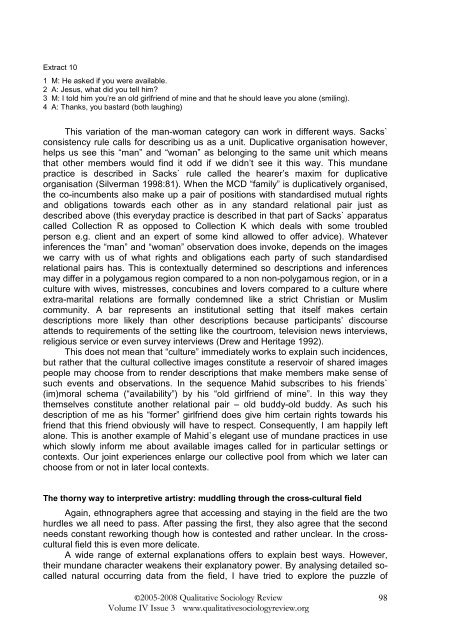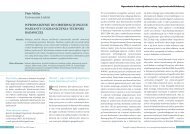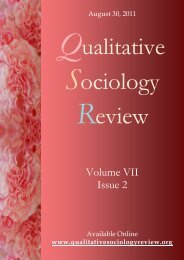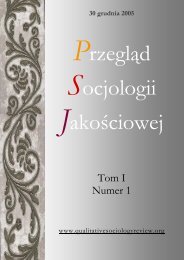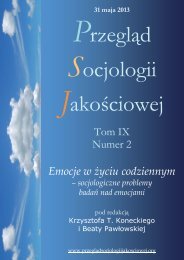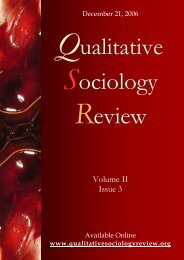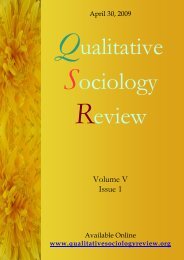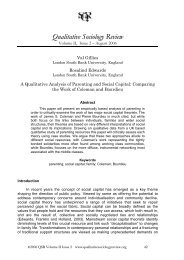volume IV is 3 - Qualitative Sociology Review
volume IV is 3 - Qualitative Sociology Review
volume IV is 3 - Qualitative Sociology Review
You also want an ePaper? Increase the reach of your titles
YUMPU automatically turns print PDFs into web optimized ePapers that Google loves.
Extract 10<br />
1 M: He asked if you were available.<br />
2 A: Jesus, what did you tell him?<br />
3 M: I told him you’re an old girlfriend of mine and that he should leave you alone (smiling).<br />
4 A: Thanks, you bastard (both laughing)<br />
Th<strong>is</strong> variation of the man-woman category can work in different ways. Sacks`<br />
cons<strong>is</strong>tency rule calls for describing us as a unit. Duplicative organ<strong>is</strong>ation however,<br />
helps us see th<strong>is</strong> “man” and “woman” as belonging to the same unit which means<br />
that other members would find it odd if we didn’t see it th<strong>is</strong> way. Th<strong>is</strong> mundane<br />
practice <strong>is</strong> described in Sacks` rule called the hearer’s maxim for duplicative<br />
organ<strong>is</strong>ation (Silverman 1998:81). When the MCD “family” <strong>is</strong> duplicatively organ<strong>is</strong>ed,<br />
the co-incumbents also make up a pair of positions with standard<strong>is</strong>ed mutual rights<br />
and obligations towards each other as in any standard relational pair just as<br />
described above (th<strong>is</strong> everyday practice <strong>is</strong> described in that part of Sacks` apparatus<br />
called Collection R as opposed to Collection K which deals with some troubled<br />
person e.g. client and an expert of some kind allowed to offer advice). Whatever<br />
inferences the “man” and “woman” observation does invoke, depends on the images<br />
we carry with us of what rights and obligations each party of such standard<strong>is</strong>ed<br />
relational pairs has. Th<strong>is</strong> <strong>is</strong> contextually determined so descriptions and inferences<br />
may differ in a polygamous region compared to a non non-polygamous region, or in a<br />
culture with wives, m<strong>is</strong>tresses, concubines and lovers compared to a culture where<br />
extra-marital relations are formally condemned like a strict Chr<strong>is</strong>tian or Muslim<br />
community. A bar represents an institutional setting that itself makes certain<br />
descriptions more likely than other descriptions because participants’ d<strong>is</strong>course<br />
attends to requirements of the setting like the courtroom, telev<strong>is</strong>ion news interviews,<br />
religious service or even survey interviews (Drew and Heritage 1992).<br />
Th<strong>is</strong> does not mean that “culture” immediately works to explain such incidences,<br />
but rather that the cultural collective images constitute a reservoir of shared images<br />
people may choose from to render descriptions that make members make sense of<br />
such events and observations. In the sequence Mahid subscribes to h<strong>is</strong> friends`<br />
(im)moral schema (“availability”) by h<strong>is</strong> “old girlfriend of mine”. In th<strong>is</strong> way they<br />
themselves constitute another relational pair – old buddy-old buddy. As such h<strong>is</strong><br />
description of me as h<strong>is</strong> “former” girlfriend does give him certain rights towards h<strong>is</strong><br />
friend that th<strong>is</strong> friend obviously will have to respect. Consequently, I am happily left<br />
alone. Th<strong>is</strong> <strong>is</strong> another example of Mahid`s elegant use of mundane practices in use<br />
which slowly inform me about available images called for in particular settings or<br />
contexts. Our joint experiences enlarge our collective pool from which we later can<br />
choose from or not in later local contexts.<br />
The thorny way to interpretive art<strong>is</strong>try: muddling through the cross-cultural field<br />
Again, ethnographers agree that accessing and staying in the field are the two<br />
hurdles we all need to pass. After passing the first, they also agree that the second<br />
needs constant reworking though how <strong>is</strong> contested and rather unclear. In the crosscultural<br />
field th<strong>is</strong> <strong>is</strong> even more delicate.<br />
A wide range of external explanations offers to explain best ways. However,<br />
their mundane character weakens their explanatory power. By analysing detailed socalled<br />
natural occurring data from the field, I have tried to explore the puzzle of<br />
©2005-2008 <strong>Qualitative</strong> <strong>Sociology</strong> <strong>Review</strong><br />
Volume <strong>IV</strong> Issue 3 www.qualitativesociologyreview.org<br />
98


